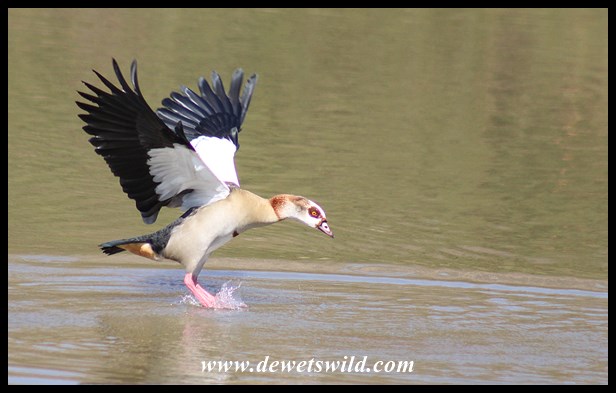Alopochen aegyptiaca
The well-known Egyptian Goose is a large (up to 3.5kg) duck that is probably South Africa’s most numerous waterfowl species.
Egyptian Geese inhabit almost every freshwater habitat, preferring rivers and waterbodies with open shorelines within easy reach of open fields for grazing. Their diet is mostly vegetarian, particularly including grasses and cultivated crops (which is why they are regarded as pests in some parts of their range).
Outside of the breeding season, which in South Africa mainly stretches from late winter to early summer, Egyptian Geese can be found in large flocks of hundreds, even thousands, especially so while moulting (which leaves them flightless for about a month). In the breeding season however pairs are more solitary in habit, viciously defending small territories around their nests and goslings from others of their kind. Nests, lined with plant material, are bult in a variety of places ranging from shallow depressions hidden on the ground in thick vegetation to burrows, the abandoned nests of other large birds, holes in trees, cliffs, caves and buildings. Pair bonds often last for life, and the females incubate the clutch of 5 to 11 eggs for about 4 weeks. Chicks hatched in elevated nests have to jump out after hatching, responding to the call of their mother below, and then follow the parents to water. Both parents take care of the young, which start flying at around 10 weeks of age.
The IUCN considers the Egyptian Goose as being of “Least Concern“, having a large (though likely decreasing) population distributed over most of Sub-Saharan Africa, with introduced or feral populations in many other parts of the world. Ironically they no longer occur on the lower Nile, where they were once considered sacred by the ancient Egyptians. They are however a very familiar sight all over South Africa.













































































Ek wonder… sal hulle lekker smaak? 😉
LikeLiked by 1 person
Hul sal darem n bietjie vleisies hê om af te kou!
LikeLiked by 2 people
Ek dink ons moet braai! 😉
LikeLiked by 1 person
Ha ha, hier in NZ ken hul nie van lekker braai nie. Selfs n kolgans wat gebrai is sal dalk heerlik wees op n boere braaivleis manier gedoen. Hul gebruik gasbranders om te braai!!!!
LikeLiked by 2 people
Ja… hie in Ierland is gas ook groot! Ek het vir my ‘n 44G drom gekry en ‘n braai gebou! Ek moet now weer so maak want my braai is vrot geroes! 😉
LikeLiked by 1 person
Mooi man. As ons braai dan gebruik ons ook hout want hier glo hul ook nie aan houtskool wat sulke lekker warm kole maak nie. Hier is wel n SA winkel waar ons regte Boerewors kan koop.
LikeLiked by 2 people
Ons SA winkel verkoop regte houtskool en soms ysterhout! Maar in die somer verkoop ‘n paar van die groot kettangwinkels ook redelike goeie gehalte koutskool! 😉
LikeLike
Jul is gelukkig. Hier is niks nie.
LikeLike
Volgens my boeke wou nie eers die Engelse “explorers” van ouds hulle regtig eet nie…
LikeLiked by 1 person
lovely-so reminded of the duckling in the Disneyland pond.
LikeLiked by 1 person
They’re just not as friendly though!
LikeLike
Beautiful pictures. It´s so many nice birds I never heard about before. Thanks for sharing! 🙂
LikeLike
Glad to know you like our series on South Africa’s wildlife so much, thanks John!
LikeLiked by 1 person
My computer hasn’t been loading pages well – slow internet to blame… your page today is especially difficult to read.. the dark/light/med values of the tree foliage conflicts with the text… the geese are lovely, and those little ones – ah, all babies are the darlings of our world!
LikeLiked by 1 person
Thanks for another kind comment, Lisa! Sorry to hear of that the slow internet connection you’re struggling with, hope it will be resolved soon.
LikeLike
They really are very beautiful birds. There are about half a dozen pairs in the area where I live and they often stalk around the school playing fields and have even come into my garden and spent some time in the pool.
LikeLike
Lucky you, Kim! Just goes to show how safe your garden must feel to them.
LikeLike
Lovely goose! But why has his wife given him a black eye?! 🙂
LikeLiked by 2 people
Probably because he’s always looking for a fight! 😀
LikeLiked by 1 person
Haha! 😁
LikeLike
Ek wil soms die twee kolganse wat my Sondagoggende vanaf my bure se dak, ons douvoordag wakker krys,se nekkies omdraai! ‘n Kolgans in vlug, is darem ‘n mooi ding, Dries. Weereens pragtige foto’s!
LikeLiked by 1 person
Ai nee Dina, jy is heeltemal te lief vir diere om tot daai uiterstes te gaan! 😀
LikeLiked by 1 person
Hehe,maar so deur die Sondag slaapnewels,koester ek diep donker gedagtes!
LikeLiked by 1 person
😀
LikeLiked by 1 person
Ek wou juis vra of dit n kolgans is toe antw jy sommer my vraag. In Secunda waar ek n tyd lank gebly het het elke mensgemaakte dam kolganse en tonne eende gehad en dan saans die menigte bosluisvoëls wat die wilgerbome op eilande volsit om te oornag!
LikeLiked by 2 people
Ek is bly ek kon help!
LikeLiked by 2 people
Very Cleopatra looking with the black circle around the eye’s! Also very regal! 🙂
LikeLiked by 2 people
Another reason why they seem to deserve their name, thanks Teresa!
LikeLiked by 1 person
Beautiful colors on the adults, but that little gosling….. adorable!
LikeLiked by 2 people
They’re very cute and fluffy, but don’t think the parents will let you get anywhere near them!
LikeLiked by 1 person
a relative of the magpie geese?
LikeLike
Not closely related, Kate – both species are of the same bird order (Anseriformes), but not in the same family.
LikeLiked by 1 person
ah good I am learning much from you, thanks 🙂
LikeLiked by 1 person
We learn together!
LikeLiked by 1 person